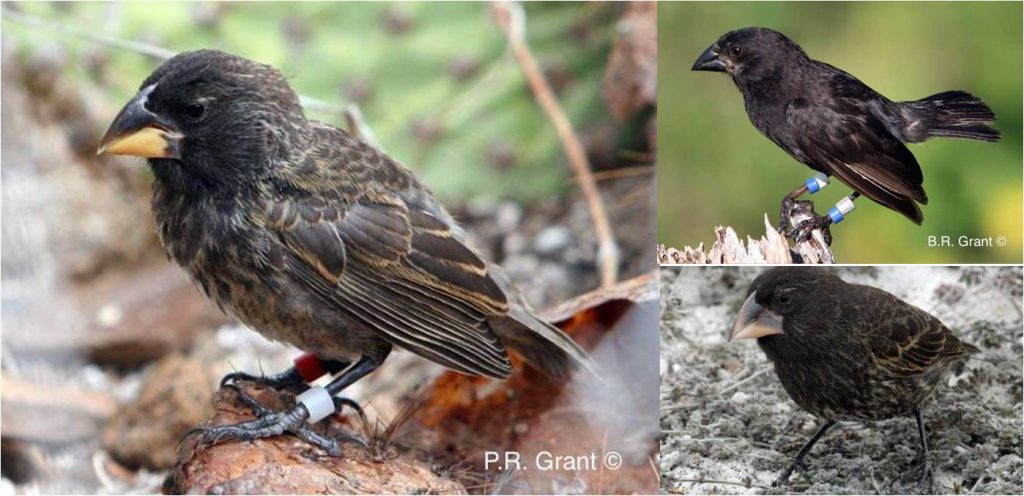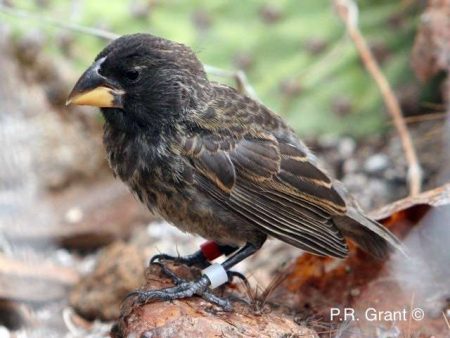September 13, 2018 – When HMS Beagle arrived at the Galapagos Islands in 1835 with a young Charles Darwin aboard, few at the time could have anticipated that observations made about various species of finches would lead to the theory of evolution. Darwin carefully catalogued 18 different species of these birds showing how they were related, and leading to his conclusion that they must have come from a common ancestor. Today with DNA analysis we can pinpoint the divergence that produced the variable characteristics of Darwin’s finches across the Galapagos Archipelago. That common ancestor arrived several million years before the HMS Beagle with its descendants filling numerous ecological niches based on the microclimates of the island chain.
The 18 different finches that Darwin noted, however, do not represent the end of evolution for these birds in the Galapagos. The unique environment of the islands favours rapid evolution. A bird from one species on one of the islands could conceivably fly to another and mate with a neighbouring species to create a hybrid.
And that is exactly what has happened with the arrival of a new finch appearing on Isla Daphne Mayor, one of the smaller and more remote members of the Galapagos Archipelago. It appears that an immigrant male finch identified as Geospiz conirostris, a cactus finch, normally resident on Isla Espanola, some 100 kilometers (62 miles) south of Daphne Mayor, arrived on the island somewhere around 1981. Reproductively isolated the finch mated with Geospiz fortis, one of the three resident Daphne Mayor species. This produced a set of new offspring far different from the native species of the island. The subsequent descendants interbreeding among themselves led to the emergence of an entirely new species of finch within two generations.
In a study entitled “Rapid hybrid speciation in Darwin’s finches,” published in the journal Science in January of this year, biologists from Uppsala University, the Swedish University of Agricultural Sciences, Harvard, and Texas A&M, describe the new species and how it came about while offering an explanation of why it established itself in a unique econiche on the island previously unexploited by the three other native species. Literally, within the period of the study, these researchers have witnessed evolution of a new species which they named Big Bird because of its larger beak size.
How could two entirely different species interbreed and create breeding offspring?
Evolutionary scientists point to horses and donkeys and their sterile offspring, mules, as a common occurrence when two different but related species mate. But today we know that the rule doesn’t necessarily apply. For example, in the study of the evolution of our human DNA, we know that our ancestors interbred with Homo neanderthalensis and that all of us alive today contain Neanderthal DNA. So our human ancestors produced offspring capable of reproduction when mating with a different but related species.
And that appears to be the same in the case of Darwin’s finches. In the Galapagos, it is the isolation of geography that has led to 18 separate but related species. And when the opportunity has arisen because a breeding age finch goes off course and arrives on an island far from home, it can lead to interbreeding and the development of a new species with subsequent generations creating a large enough breeding population. And what’s more remarkable is how quickly this can come about.
So our notion of evolution and survival of the species as being a slow process is turned upside down by what these researchers have seen on Isla Daphne Mayor. The authors further state in the study that the likelihood of this type of evolution of new species among Darwin’s finches has probably been happening many times because of similar accidental amorous rendezvous by far flying finches. So welcome, Big Bird, a new species of finch that may flourish or die in due time. One of the authors of the study states, “Charles Darwin would have been excited to read this paper.”

















